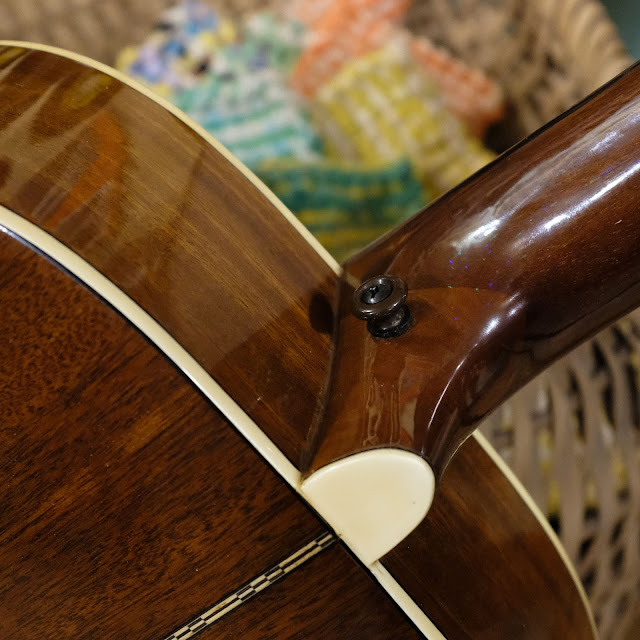1970s Yamaha FG-331 000-Size Flattop Guitar
Yamahas! I love the design of their mass-market old guitars -- thin, quality ply for the body plus light bracing and practical, sturdy necks is a winning combination -- you get good bass, good volume, and good punch combined with durability, too. I know that sounds like me talking them up a lot -- but it's true. If you've been around older ones that've been serviced and are playing well, it's pretty hard to not recognize the bang-for-the-buck on these.
This slightly-smaller-than 000-size FG-331 was made in Taiwan around the late '70s and has that beige, oval-style label in the soundhole. It's in good condition overall but the top definitely has a bunch of smaller scuffs, dings, and playwear. The back and sides are in better shape. Its truss-rod works 100% and it's playing spot-on with 3/32" EA and 1/16" DGBE action at the 12th fret. Because these can get overdriven-sounding with heavier gauges, I've used 54w, 40w, 30w, 22w, 16, 12 on it. There's decent saddle-height left after work, too.
Work included a fret level/dress, minor shave to the bridge (I took 1/16" off the top to allow more saddle travel and then buffed it back up), cleaning, and a good setup. It's ready to go and this guitar is very loud. It has a lot of reserve power -- which is good, because it sounds best using moderate force rather than a heavy hand. The sound is good fingerpicked and flatpicked, both, but because the high-end of any ply mellows out with fingerstyle approach, this gains extra brownie points as a fingerpicker.
Specs are: 25" scale, 1 11/16" nut width, 1 7/16" string spacing at the nut, 2" spacing at the bridge, 15" lower bout, 11" upper bout, and 4 1/8" side depth at the endblock. The board has something like a 14" radius and the neck has a medium-depth, Martin-ish C/V back shape.
Materials are: mahogany (or nato?) neck with rosewood fretboard and bridge, ply spruce top, ply mahogany back and sides. The guitar is 100% original right down to the pins. The pickguard looks black in the pictures but is actually a dark red tortoise. The saddle has one old chip-out that was repaired on its bass-side extremity in the past, but doesn't come close to the strings so doesn't matter. I left it because it's cute that someone took the time to glue that little bit back on...
The Japanese tuners are actually pretty standard-fare period openbacks under those covers. I seated all of the mounting screws a little better, tightened them all up, lubed them, and put them all back on the headstock and they're working just fine.
I also added a brown, plastic strap button from my parts-bins at the heel. Why not be prepared for standing?
















Comments
Thanks for any response.
I've got the plastic Martin pins in several of mine currently. Perfect fit, their Ebony ones should be the same.